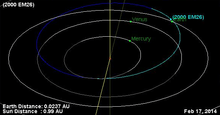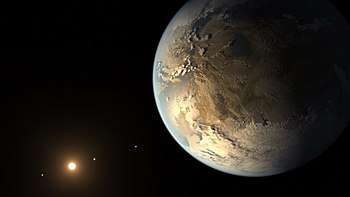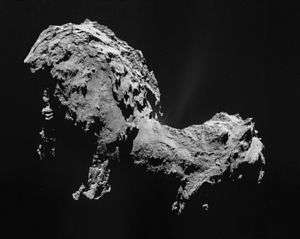2000 EM26
2000 EM26 is a near-Earth and potentially hazardous asteroid. It was discovered on 5 March 2000 and observed through 14 March 2000, by which time it had dimmed to apparent magnitude 20[4] and was 40 degrees from the moon.[5] By 17 March 2000 it was only 4 degrees from a 90% waxing gibbous moon.[5] It has never been listed on the Sentry Risk Table because none of the potential orbital solutions create a risk of impact in the next ~100 years. The asteroid is up to 270 meters (890 feet) in diameter and safely passed by Earth on 17–18 February 2014.[6] Due to the poorly determined orbit, the asteroid may have been significantly further from Earth and dozens of degrees from where the telescope was pointed during the 2014 approach.
 Approximate orbit of 2000 EM26 | |
| Discovery | |
|---|---|
| Discovery date | 5 March 2000[1] |
| Designations | |
| none | |
| Orbital characteristics[1] | |
| Epoch 23 March 2018 (JD 2458200.5) | |
| Uncertainty parameter 2 | |
| Observation arc | 17 years[1] |
| Aphelion | 1.1985 AU (179.29 Gm) |
| Perihelion | 0.43573 AU (65.184 Gm) |
| 0.81711 AU (122.238 Gm) | |
| Eccentricity | 0.46674 |
| 0.74 yr (269.8 d) | |
Average orbital speed | 12.37 km/s (27,700 mph)[2] |
| 284.64° | |
| 1.3357°/day | |
| Inclination | 3.8458° |
| 345.16° | |
| 24.167° | |
| Earth MOID | 0.0188 AU (2.81 Gm) |
| Jupiter MOID | 4.25 AU (636 Gm) |
| Physical characteristics | |
| Dimensions | 120–270 meters (390–890 feet)[3] |
| 22.6[1] | |
Observations
The 2014 approach was broadcast live (YouTube archive[7]) on the Internet at 09:00 pm EST (02:00 UTC), 18 February 2014, by the Slooh community observatory.[2][8][9] Slooh's observatory on Mount Teide in Spain's Canary Islands was iced over at the time, so images from the Slooh observatory in Dubai were used to attempt detection of the asteroid. At the time of the broadcast, no obvious image of the asteroid could be seen.[6] Some viewers complained by Twitter that it was boring when the object was never shown in the images, while others said that "boring" was a good outcome for a pass-by.[10]
Orbit
2000 EM26 is an Aten-family asteroid,[1] and as such is often near the glare of the Sun as the asteroid seldom travels outside Earth's orbit when the Earth is nearby. The orbit was poorly constrained in 2014 since the asteroid had an observation arc of only 9 days creating an orbital uncertainty of 7.[1] Since the asteroid had not been observed since 14 March 2000, the uncertainty region had kept increasing.[1] During the 2014 approach, 17 February 2014 was the first day that the nominal orbit had a solar elongation more than 90 degrees from the Sun making it easier to recover under a dark sky.[11] Using the nominal orbit, the asteroid was expected to have an apparent magnitude of about 16[11] and pass 0.02 AU (3,000,000 km; 1,900,000 mi) from Earth.[1] Closest approach (perigee-geocentrical) was around 00:15 UTC on 18 February plus or minus about 13 hours.[1] Even with an observation arc of 9 days, it was known that the minimum possible close approach distance to Earth on 18 February 2014 was 0.018 AU (2,700,000 km; 1,700,000 mi) with a small chance that the asteroid would pass as far as 0.13 AU (19,000,000 km; 12,000,000 mi) from Earth.[1] Due to the uncertainty region of the asteroid, the asteroid could have been 75 degrees from the nominal position in the sky on 18 February 2014.[11]
2000 EM26 was recovered on 24 February 2017 at magnitude 21, extending the observation arc to 17 years.[12] It is now known that 2000 EM26 passed 0.03665 AU (5,483,000 km; 3,407,000 mi) from Earth on 17 February 2014.[1]
Physical characteristics
With an absolute magnitude (H) of 21.7,[1] the asteroid is estimated as around 120–270 m (390–890 ft) in diameter, depending on the albedo (the amount of light it reflects).[3]
See also
References
- "JPL Small-Body Database Browser: (2000 EM26)". NASA. Archived from the original on 17 February 2014. Retrieved 29 March 2016.
- Staff (16 February 2014). "A 270m asteroid is to swing past Earth almost exactly a year after a meteor burst over Russia". Herald Sun. Retrieved 16 February 2014.
- "Absolute Magnitude (H)". NASA/JPL. Retrieved 17 February 2014.
- "2000 EM26 Orbit". Minor Planet Center. Archived from the original on 22 February 2014. Retrieved 21 February 2014.
- "2000EM26 Ephemerides for 1 March 2000 through 1 April 2000". NEODyS (Near Earth Objects – Dynamic Site). Archived from the original on 22 February 2014. Retrieved 21 February 2014.
- Saul, Heather (18 February 2014). "Asteroid 2000 EM26 'as big as three football fields' hurtles past Earth". The Independent. Retrieved 18 February 2014.
- Staff (18 February 2014). "Potentially Hazardous Asteroid Zipping by Earth on Close-Approach (video, 57:50)". YouTube. Retrieved 18 February 2014.
- Staff (14 February 2014). "Potentially hazardous asteroid 2000 EM26 zipping by Earth on close approach on February 17". Phys.org. Retrieved 17 February 2014.
- Kramer, Miriam (15 February 2014). "Huge Asteroid to Fly Safely By Earth Monday: Watch It Live". Space.com. Retrieved 17 February 2014.
- Weise, Elizabeth (18 February 2014). "Monster asteroid whizzes by Earth". USA Today. Retrieved 18 February 2014.
- "2000EM26 Ephemerides for 16 February 2014 through 21 February 2014". NEODyS (Near Earth Objects – Dynamic Site). Archived from the original on 17 February 2014. Retrieved 17 February 2014.
- "MPEC 2017-D78 : 2000 EM26". IAU Minor Planet Center. 25 February 2017. Retrieved 2 March 2018. (K00E26M)
External links
| Wikimedia Commons has media related to 2000 EM26. |


